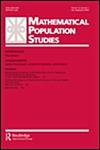Editorial: Methods and Applications in Spatial Demography: 2.
IF 1.3
3区 社会学
Q3 DEMOGRAPHY
Mathematical Population Studies
Pub Date : 2020-01-01
Epub Date: 2020-02-11
DOI:10.1080/08898480.2020.1715123
引用次数: 2
Abstract
As a self-described, spatial demographer, and with a formative background in geography and planning, I am interested in substantive questions at the nexus of demography, geography, quantitative methods, and public policy. I believe that addressing contemporary substantive demographic and public policy-related questions increasingly requires an understanding of spatial concepts, data, and methods. Spatial concepts are seemingly simultaneously both well-known yet ironically ignored; for example, the concept of spatial dependence. However, levels of ignorance surrounding fundamental spatial concepts are waning (Logan, 2012; Matthews, 2016). Indeed, the increased familiarity with spatial concepts in academia and among policy makers (and also among the lay public) is a product of technological and computational developments that enhance the ability to collect, store, integrate, analyze, visualize, and interpret complex data, including spatial data. Researchers and policy makers are paying attention to old (and now digitized), new, and emerging forms of spatial data, and they recognize the need to be clear regarding a series of interrelated analytical choices, as these choices are not benign. The most relevant “spatial” choices relate to the definitions of place, geographic levels and scales of analysis, spatial interactions and any interdependencies between places, and to basic spatial concepts (for example, distance and relative location) and those that are more complex (for example, spatial heterogeneity and spatial nonstationarity). Related, in many areas of basic and applied demographic research the array of questions that are asked are often constrained by the availability of data, including the availability of spatial data. As stated above, technological changes in computational capacity coupled with the design and adoption of sophisticated data structures (relational databases) and information systems (geographic information systems) has opened up opportunities in data linkage. These opportunities in data linkage have facilitated the transition from single-level to multi-level analysis, from cross-sectional to longitudinal analysis, and from aspatial to spatial analysis. Geography has emerged as one of the main organizing frameworks for both hierarchical and complex nonhierarchical data structures. Leveraging geography, specifically location and relative location data, enables the编辑:空间人口学的方法与应用;
本文章由计算机程序翻译,如有差异,请以英文原文为准。
求助全文
约1分钟内获得全文
求助全文
来源期刊

Mathematical Population Studies
数学-数学跨学科应用
CiteScore
3.20
自引率
11.10%
发文量
7
审稿时长
>12 weeks
期刊介绍:
Mathematical Population Studies publishes carefully selected research papers in the mathematical and statistical study of populations. The journal is strongly interdisciplinary and invites contributions by mathematicians, demographers, (bio)statisticians, sociologists, economists, biologists, epidemiologists, actuaries, geographers, and others who are interested in the mathematical formulation of population-related questions.
The scope covers both theoretical and empirical work. Manuscripts should be sent to Manuscript central for review. The editor-in-chief has final say on the suitability for publication.
 求助内容:
求助内容: 应助结果提醒方式:
应助结果提醒方式:


